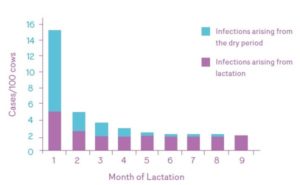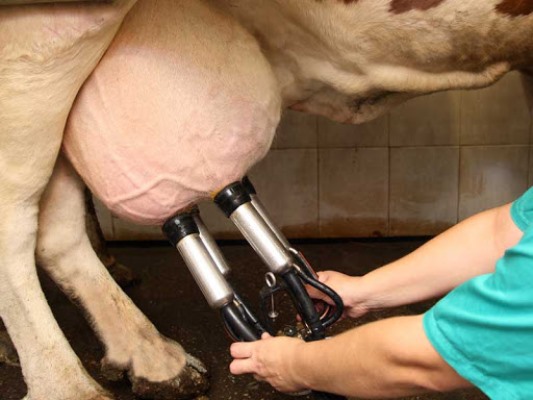Reducing Mastitis of Dry Period Origin
11 February 2020Clinical mastitis of dry period origin refers to cases occurring within the first 30 days after calving. There is a high probability that these cases are due to environmental infections being picked up during the dry period and go on to cause clinical mastitis throughout the following lactation, even if the infection is not detected during the dry period (see diagram below). Therefore, for herds experiencing high levels of mastitis in the first month of lactation, prevention needs to focus on dry cow management.
The Origin of Infection in Clinical Mastitis Cases
Source: Green et al, (2002)
The two key times of increased infection risk are the first week after drying off and in the week prior to calving. One of the key natural defences against infection in the dairy cow is formation of the keratin plug, which prevents bacteria entering the teat canal during the dry period. However, not all cows form a plug that is effective during the whole of the dry period, as formation of the plug is slow after drying off (especially in higher yielding cows). Some studies have shown that up to 50% of quarters are still open by 10 days after drying off.
During the late part of the dry period the keratin plug slowly breaks down in preparation for lactation. This is why the use of an internal teat sealant can help and they have been shown to be as effective as antibiotics in preventing intrammammary infections during the dry period in cows which were uninfected at drying off.
For cows that are infected at drying off a combination of antibiotic and internal teat sealant will greatly reduce infections in the latter part of the dry period, when antibiotic concentration is declining. The somatic cell count (SCC) and clinical mastitis history can be used to indicate whether a cow is infected at dry off. The cut-off chosen can depend on the age profile of the herd, the mastitis pathogens within the herd and the dry period environment and so should be discussed with your vet.
Cow risk factors for mastitis of dry period origin include milk yield at drying off, age and teat end condition, with older cows being more susceptible. Poor teat end condition (e.g. hyperkeratosis) can be caused by a number of factors including teat end shape and skin condition, overmilking, ACR settings and milking plant vacuum level. It predisposes the teats to colonisation by bacteria as they are more difficult to clean and disinfect. Cracked teats are at 1.8 times more risk of picking up new infections during the dry period. Drying off treatment is important and if selective dry cow therapy is being practiced, hygiene at drying off and cleanliness and management of the housing environment for dry cows becomes even more critical.
The vast majority of dry period infections are caused by environmental bacteria, such as Strep uberis and E.coli. Therefore, the infection risk can be controlled by good management of the dry cow housing environment and by boosting the cow’s immunity through adequate nutrition and management practices to reduce stress.
Avoid overstocking dry cow facilities and straw courts should have plenty of space (ideally 1.25 square metres per 1000 litres herd average production). They should be cleaned out at least once a month and more frequently if stocking density is higher. Calving pens should be cleaned out daily and cubicles should be scraped and bedded every day. Adequate ventilation must also be provided. Fresh, clean air will help reduce the bacterial count of bedding as bacteria require humid conditions to grow.
Dry cows at grass can be difficult to manage from an udder health point of view and a key factor in reducing mastitis in the post-calving period is to follow a pasture rotation policy where the grass is rested for four weeks and grazed for two. Avoid set stocking of cows close to calving in paddocks for long periods, and take measures to limit poaching around access gates and feeders.
More than 1 in 12 cows with clinical mastitis in the first 30 days of lactation and/or 10% of cows calving in with a SCC of greater than 200,000cells/ml indicates that there is likely to be a problem of dry period origin.
Reference
Green MJ, Green LE, Medley GF, Schukken YH, Bradley AJ. Influence of dry period bacterial intramammary infection on clinical mastitis in dairy cows. Journal of Dairy Science 2002;85(10):2589–99
Lorna MacPherson for the Farm Advisory Service
Sign up to the FAS newsletter
Receive updates on news, events and publications from Scotland’s Farm Advisory Service


